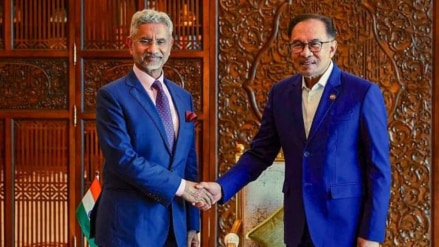In the coming weeks, Malaysia’s Prime Minister Anwar Ibrahim is set to visit India, marking a significant moment in the diplomatic relations between the two nations. This visit follows closely on the heels of Indian Prime Minister Narendra Modi’s planned trips to Poland and Ukraine later this month.
The visit is expected to focus on a broad spectrum of issues, including trade, science and technology, education, agriculture, tourism, defence, and regional concerns such as the situations in Bangladesh, Myanmar, and West Asia.
Strengthening Bilateral Ties
The forthcoming visit is an extension of the ongoing efforts to deepen the already strong ties between India and Malaysia. Recently, Indian External Affairs Minister S. Jaishankar visited Kuala Lumpur as part of his tour of Southeast Asia, where he met with Prime Minister Anwar Ibrahim. Their discussions covered a wide array of subjects, including trade, digital cooperation, defence, and regional issues like the crisis in Myanmar. One of the key outcomes of their meeting was Malaysia’s commitment to facilitating the establishment of a branch campus of the Indian Institute of Technology (IIT) in Malaysia, a significant step towards enhancing educational collaboration between the two countries.
Revisiting the India-Malaysia Free Trade Agreement
A critical issue likely to dominate discussions during the Malaysian Prime Minister’s visit is the review of the India-Malaysia Free Trade Agreement (FTA), formally known as the Comprehensive Economic Cooperation Agreement (CECA). Implemented in July 2011, this agreement was designed to boost trade in goods, services, and investments between the two countries. However, despite the intentions behind CECA, India has seen a growing trade deficit with Malaysia, mirroring its experience with the broader India-ASEAN FTA.
In the fiscal year 2010-2011, when CECA was signed, India had a trade deficit of US$2.65 billion with Malaysia. By 2023-24, this deficit had expanded to US$5.49 billion, despite an increase in exports. India’s exports to Malaysia stood at US$7.26 billion, while imports from Malaysia reached US$12.75 billion during the same period. This growing trade imbalance has prompted India to seek a review of the FTA, aiming to make the trade basket more balanced and mutually beneficial.
India’s Commerce Department has already begun gathering input from various industry bodies and export promotion councils to identify tariff and non-tariff barriers that hinder trade with Malaysia. This input will form the basis of India’s agenda in the upcoming joint commission meeting with Malaysia, where both sides are expected to discuss potential adjustments to the FTA. One area of focus may be on Product Specific Rules of Origin (PSR), which determine the national source of a product and could offer more flexibility to certain Indian exports.
Expanding Defence and Maritime Cooperation
Another crucial aspect of the visit will be discussions on defence and maritime cooperation, areas where both India and Malaysia see significant potential for growth. The two countries have already identified key areas for collaboration, including government-to-government engagement, tri-service cooperation, training, UN peacekeeping operations, and bilateral services engagement. Moreover, there is a strong interest in defence industrial cooperation, particularly in research and development, and regional engagements.
Malaysia has expressed confidence in India’s defence industry capabilities and is keen to explore possibilities for co-design, co-production, and co-development in various sectors. One area of potential collaboration is in shipbuilding and maintenance, where India’s expertise could complement Malaysia’s needs. Additionally, both countries share common platforms in their armed forces, such as the Sukhoi fighter jets and Scorpene submarines, which could serve as a basis for deeper technical cooperation.
India’s Hindustan Aeronautics Limited (HAL) has manufactured around 280 Sukhoi fighter jets in collaboration with Russian counterparts, and this experience could be invaluable for Malaysia’s air force, which operates the same platform. Similarly, India’s experience in building Scorpene submarines at Mazagon Dock Shipbuilders Ltd. could be of great interest to Malaysia, which also operates a fleet of these submarines. Furthermore, Malaysia is keen on leveraging Indian expertise in emerging technologies like cybersecurity, artificial intelligence, and the Maintenance, Repair, and Overhaul (MRO) sector, particularly for submarine parts.
Addressing Regional Concerns
The visit is also expected to include discussions on regional issues, with a particular focus on the situations in Bangladesh, Myanmar, and West Asia. Both India and Malaysia share concerns about the ongoing crises in these regions and are likely to explore ways to collaborate more effectively in addressing them. The Rohingya refugee crisis in Bangladesh and Myanmar, in particular, is a matter of mutual concern, as both countries have been involved in providing humanitarian aid and seeking a peaceful resolution to the conflict.
Bottomline
Prime Minister Anwar Ibrahim’s visit to India comes at a critical juncture in the bilateral relations between the two countries. With a focus on enhancing trade ties, expanding defence cooperation, and addressing regional challenges, this visit is expected to further strengthen the strategic partnership between India and Malaysia. As both nations navigate the complexities of regional and global dynamics, their collaboration is likely to play a pivotal role in shaping the future of Southeast Asia.
